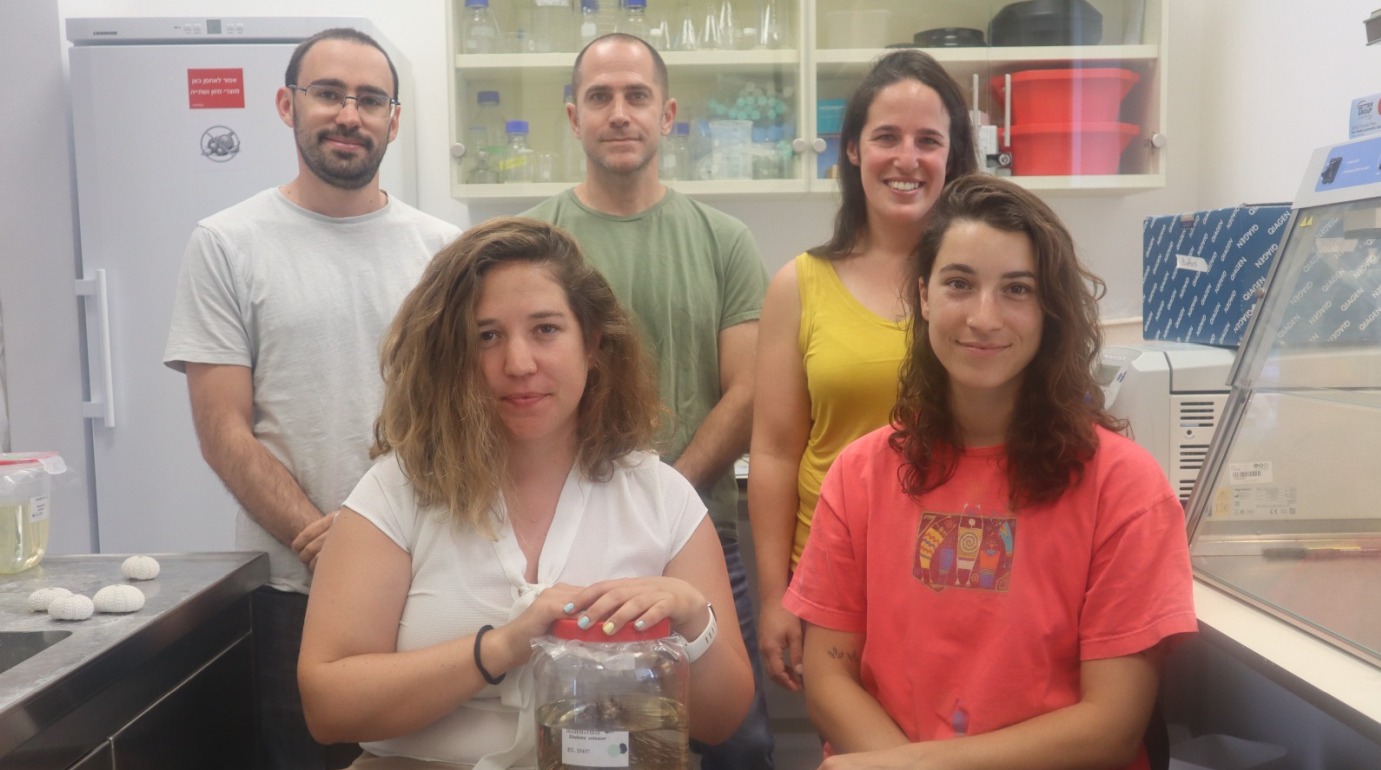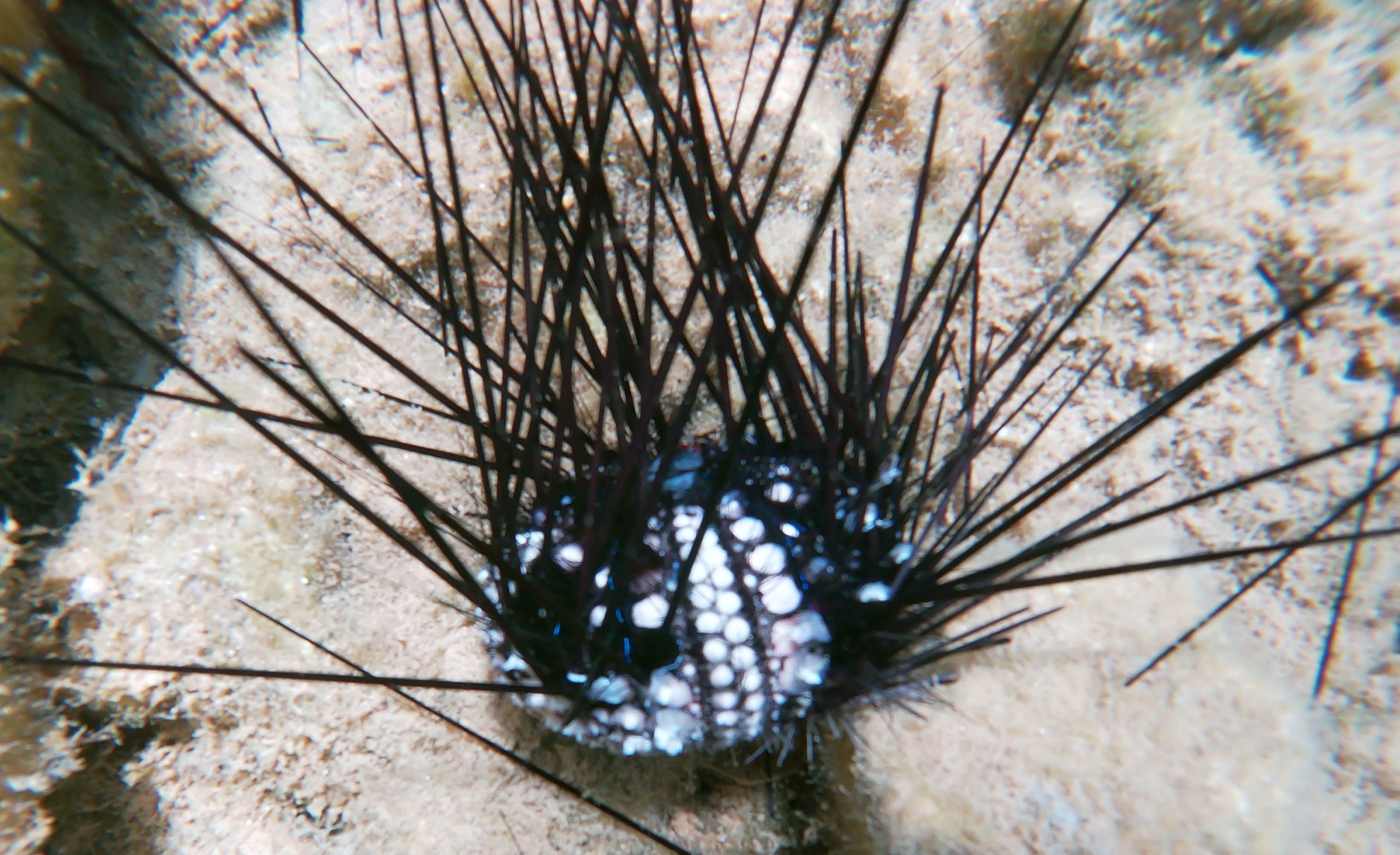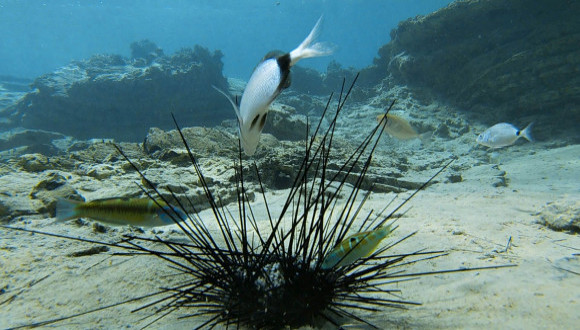Within just a few months a deadly epidemic killed all the black sea urchins in the Gulf of Eilat
Mass mortality of sea urchins in the Mediterranean Sea has spread to the Gulf of Eilat and threatens to destroy the coral reef. Within just two days a healthy sea urchin becomes a skeleton with no tissues
A series of new, disturbing studies from Tel Aviv University reveal a deadly epidemic causing mass mortality of black sea urchins in the Mediterranean Sea and the Gulf of Eilat. The entire population of black sea urchins in Eilat was wiped out over a couple of months. For example, thousands of sea urchins living in a site near the northern shore of the Gulf of Eilat died out over the course of a few weeks. The epidemic was so severe, that today no living black sea urchins have remained at the site, only skeletons. The same has happened at other sites in the Gulf of Eilat. The studies note that such extensive mortality is also occurring in other countries in the region, including Jordan, Egypt, Saudi Arabia, Greece, and Turkey.
The researchers emphasize that sea urchins in general, and the long-spined Diadema setosum in particular, are considered key species essential for the healthy functioning of the coral reef. The researchers: "It must be understood that the threat to coral reefs is already at an all-time peak, and now a previously unknown variable has been added. This situation is unprecedented in the entire documented history of the Gulf of Eilat."
The researchers assume that the source of the deadly epidemic is a pathogenic ciliate parasite that has spread from the Mediterranean to the Red Sea. An urgent report describing the current situation was submitted to the Israel Nature and Parks Authority, and emergency steps for protecting Israel's coral reefs are now under consideration.
The studies were led by Dr. Omri Bronstein and PhD students Rotem Zirler, Lisa-Maria Schmidt, Gal Eviatar, and Lachan Roth from the School of Zoology, Wise Faculty of Life Sciences, and The Steinhardt Museum of Natural History at Tel Aviv University. The papers were published in Frontiers in Marine science and Royal Society Open Science.

Dr. Bronstein: "At first we thought it was some kind of pollution or poisoning, or a local chemical spill, from the industry and hotels in the north of the Gulf of Eilat, but when we examined additional sites in Eilat, Jordan, and Sinai, we quickly realized that this was not a local incident. All findings pointed to a rapidly spreading epidemic. Similar reports are coming in from colleagues in Saudi Arabia. Even sea urchins that we grow for research purposes in our aquariums at the Interuniversity Institute, and sea urchins at the Underwater Observatory Marine Park in Eilat, contracted the disease and died, probably because the pathogen got in through the pumping systems. It's a fast and violent death: within just two days a healthy sea urchin becomes a skeleton with massive tissue loss. While some corpses are washed ashore, most sea urchins are devoured while they are dying and unable to defend themselves, which could speed up contagion by the fish who prey on them."
Dr. Bronstein: "In recent years my research group has been studying the issue of marine invasions. One of the species we focus on is the long-spined Diadema setosum. Until recently this was one of the dominant species in Eilat's coral reef – the black sea urchins with long spines familiar to all of us. Sea urchins in general, and Diadema setosum in particular, are considered key species essential for the healthy functioning of coral reefs. The sea urchins are the reef's 'gardeners' – they feed on the algae and prevent them from taking over and suffocating the corals that compete with them for sunlight. Unfortunately, these sea urchins no longer exist in the Gulf of Eilat and are quickly disappearing from constantly expanding parts of the Red Sea further south."
The first reports on mass mortality reached Dr. Bronstein several months ago, from colleagues in Greece and Turkey, which the sea urchins had invaded, probably through the Suez Canal.
"In 2006 the first sea urchin of this species was discovered in the south of Turkey," adds Dr. Bronstein. "This phenomenon, known as biological invasion, has extensive ecological implications, and is widespread in the eastern Mediterranean, especially along Israel's coastline. We have been tracking the dynamics of this species' invasion in the Mediterranean since its first appearance. In 2016 we discovered the first Diadema setosum sea urchin along Israel’s Mediterranean coastline – a single urchin at the Gordon Beach in Tel Aviv. For over a decade since the first discovery in Turkey, populations in the Mediterranean remained small and usually hidden. But since 2018 the sea urchin population in the Mediterranean has been growing exponentially, reaching a state of population explosion – with giant populations of thousands and even tens of thousands found in Greece and Turkey. However, as we worked on studies summarizing the invasion of sea urchins in the Mediterranean, we began to receive reports on sudden extensive mortality. Supposedly the extinction of an invasive species is not a bad thing, but we must be aware of two major risks: First, we don't yet know how this mortality and its causes might impact local species in the Mediterranean; and second, and much more critical, the geographic proximity between the eastern Mediterranean and the Red Sea might enable the pathogen to quickly cross over to the natural population in the Red Sea. As we feared and predicted, this is what appears to have happened."

The mass mortality reminded the TAU researchers of one of the most famous and devastating events in the history of marine ecology: the disappearance of the sea urchins in the Caribbean. Until 1983 the Caribbean coral reef was a thriving tropical reef, quite similar to the coral reef in the Gulf of Eilat. Once the sea urchins disappeared, the algae multiplied without control, blocked the sunlight from reaching the corals, and the entire reef changed irreversibly – from a coral reef to an algae field."
"Last year the disease broke out again in the Caribbean, killing the surviving urchin populations and individuals," says Dr. Bronstein. "Unlike past events, today we have the scientific and technological tools to analyze the forensic evidence. A group of researchers from Cornell University identified the cause of mortality in the Caribbean: a pathogenic ciliate parasite. The pathology observed in the sea urchins dying in Greece and Turkey is identical to the pathology in the Caribbean, and it's also the pathology we see in the sea urchins dying here in the Red Sea."
Dr. Bronstein's studies were the first to identify mass mortality in an invasive species in the Mediterranean, and also the first to indicate mass mortality of sea urchins of the species Diadema setosum – one of the world's most common species of sea urchins. Dr. Bronstein concluded one of these groundbreaking studies with a warning - that the epidemic breaking out in the Mediterranean might spread to the nearby Red Sea. Unfortunately, this warning has come true.
"We must understand the seriousness of the situation: in the Red Sea, mortality is spreading at a stunning rate, and already encompasses a much larger area than we see in the Mediterranean. In the background there is still a great unknown: What is actually killing the sea urchins? Is it the Caribbean pathogen or some new unfamiliar factor? Either way, this pathogen is clearly carried by water, and we predict that in just a short time, the entire population of these sea urchins, in both the Mediterranean and the Red Sea, will get sick and die.
"In my opinion we must urgently establish a broodstock population for these sea urchins, so that if needed, we will be able to return them to nature in the future. As with COVID-19, at this point no one knows what will happen – will this epidemic disappear by itself, or will it stay with us for many years and cause a dramatic change in coral reefs? However, unlike the COVID-19 pandemic, in this case we have no way of vaccinating or treating the sea urchins, and so we must focus all efforts on prevention. The window of opportunity for preserving a healthy population of this species in Eilat has already closed. If we want to establish a broodstock population, we must do it today, by preserving healthy individuals from the Israeli Mediterranean – before the disease, spreading from the north, reaches this area. This is a complex task, but it is absolutely necessary if we wish to ensure the survival of this unique species that is so critical to the future of coral reefs."
Link to the article:
10.1098/rsos.230251





